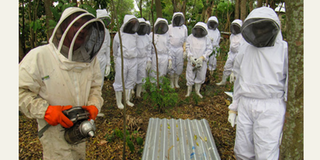Bee fences: keeping elephants out, letting high profits in

Bee keeping graduates from Rubirizi district at the periphery of Queen Elizabeth National Park. Photo by Enid Ninsiima
What you need to know:
They strained to keep elephants away from their crops, never imagining that a bee fence would be the answer to their problems.
Like many small-scale farmers, 56-year-old Agnes Ndyomubandi survives on her cotton, cassava, maize and banana gardens. Unfortunately, her home in Masaka village, Rubirizi District, sits on the periphery of Queen Elizabeth National Park (QENP) – which meant that most of her crops were being destroyed by wild animals.
“For several years, I have lost all my gardens to elephants and baboons from the park. I could not support my family,” she says.
The game park boasts of a high concentration of wildlife, and has been designated a World Heritage Site by UNESCO. But tourism and heritage aside, the man-wildlife conflict stemming from competition for resources has harmed the livelihoods of many surrounding communities.
During cotton harvest time in Kasese, people spent sleepless nights lighting fires around their gardens to scare away the animals. The method did not work, and some people have even been killed from wildlife attacks.
In Kasese District in 2010, more than 460 farmers unsuccessfully sued Uganda Wildlife Authority (UWA) in the High court, seeking compensation of more than Shs1.5 b in damages caused by wildlife to the property and crops in the previous year.
The farmers under Ikongo Farmers Marketing and Processing Cooperative Society, alleged that UWA officials were negligent in their gazetting duties, which allowed animals such as elephants to stray from the national park five miles away to destroy their soya beans, maize, pineapples, cotton, groundnuts, mangoes and bananas.
In 2010, the people of Rubirizi District asked government to erect an electric fence around the park. UWA rejected the method on the grounds that it would kill animals.
Innocent Kahwa, the community liaison officer at Volcano Safaris Partnership Trust (VSPT), an NGO that works with community and conservation projects in the area, said they had exhausted their efforts.
“We tried trenches and failed because elephants could cover them with soil. We used gun shooting to scare away the animals it also failed,” Kahwa said. “Now, we have resorted to bee fencing – and so far, so good.”
The elephant conflict mitigation project is a 60-metre fence made up of beehives, treated wood, paint, wires and iron sheets. As initiators and primary funders of the project, VSPT says the project is being piloted in the areas bordering QENP first, as a demonstration to the rest of the farmers in surrounding districts who are also prone to wildlife invasion.
“We have introduced this method to see whether it can work for us and be sustainable,” Kahwa said.
The project was built on elephant and bee research from Save the Elephants – a London-based NGO that explores natural solutions to human-elephant conflicts.
It was founded in 1993 by Dr Iain Douglas-Hamilton who made a pioneering study of elephant behaviour in the late 1960s in Lake Manyara National Park, Tanzania, and has worked on elephant research and against poaching across the continent since. The group’s 2011 report says that in its ongoing monitoring of elephant farm invasions, only one in 32 had successfully penetrated a bee fence.
Money for honey
Some farmers in Uganda have found success with an alternative method around Kibale National Park – they have managed to keep away most elephants by burning red pepper mixed with elephant droppings.
The project, initiated by Tooro Botanical gardens supported by CARE International Uganda, is in Busiriba and Kahungye Sub-counties in Kamwenge District, Kasenda and Ruteete Sub-counties in Kabarole District, and at Karwa Sub-county in Kyenjojo District. Bee fences have added benefits beyond staving off wildlife.
Malaika Honey, a group of beekeeping experts who both employ and train the local community, says bees can actually increase crop yields by up to 30 per cent – potentially worth millions more in profits to existing agriculture ventures.
Malaika Honey has trained Kasese farmers in all aspects of apiculture – the keeping of bees – as well as facilitating the costs of the pilot fence. Best practices, the use of modern technology, how to harvest honey, and how to produce propolis-a naturally produced antibiotic have shown Ndyomubandi the benefits first-hand.
“Since I joined Masaka beekeeping group, I have acquired money from honey, educated my children, got medicines from honey as well as improved on my family welfare because elephants no longer invade my gardens,” she said.
Lawrence Marembo, chairperson of the Masaka beekeeping group, which started with just 14 members with 35 beehives in 2004, says word of those benefits is spreading.
“It has protected us from elephant invasion as well as generating income for our families,” he says. While similar projects have been successfully launched in Kenya, Zambia and Australia, finding support for the little-known profession can be tough.
Malaika Honey founder and managing director Simon Turner says he hopes to continue working alongside VSPT to expand the existing fence to cover the entire 1.5km game park border.
Incorporating the production and sale of honey products and benefits into Uganda’s larger agricultural system however, for now remains a challenge, as even well established farming practices have struggled to receive government support while access to markets is a consistent roadblock.
“The main challenge we face is market for our products, we sell a kilogramme at Shs 3,000 only,” says Marembo. “At times we consume half of the harvest due to limited market.”
With an estimated 1.2m bee keepers across the country, Turner says improving on apiculture practices through more training, commercialisation of bee stocks and integration with existing agriculture ventures would stimulate markets, and see honey help Uganda reach its full potential.




